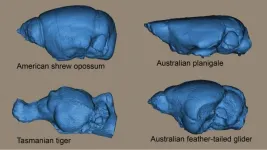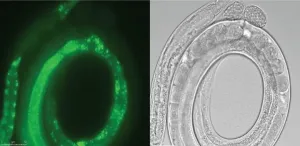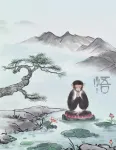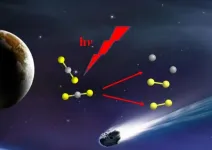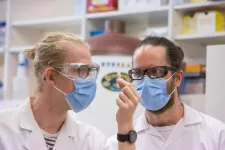(Press-News.org) Being stretchy and squeezable may be the key to finding space for the brain in mammals, including humans.
An international study, co-led by Flinders University's Vera Weisbecker, has revealed that marsupial mammals like possums, kangaroos, and wombats appear to have a lot of flexibility when it comes to accommodating their brains into their skulls.
"The brain is one of the heaviest parts of the head, particularly in smaller mammals. But it needs to be placed in a way that doesn't interfere with the many vital functions of the head, such as seeing, hearing, smelling and of course feeding," says Dr. Weisbecker.
"Stowing" a large brain into the head is a general challenge for mammals, which have much larger brains relative to their body size compared to their reptile-like ancestors. It is also a particularly intriguing issue in humans and their primate relatives, which tend to have extremely large relative brain sizes compared to other mammals."
"We wanted to use a diverse group of mammals to assess if there is general pattern of brain shape variation to explain the ability of mammals to fit their brains into the great diversity of head shapes without interfering with head function. Marsupial mammals fit the bill perfectly because they are a well-understood group of mammals with diverse head sizes and functions."
The team used CT scanning and 3D visualisation to extract the shape of the brain cavity in the diverse group of Australian marsupial mammals with the results published in the International Journal Of Organic Evolution.
"These so-called "endocasts" give us a good idea of what the brain itself looks like", says Dr. Weisbecker.
"I then placed landmarks - which work a bit like a coordinate system for shape - all over the endocasts of just under 60 marsupial species, including some really cool fossils like the marsupial lion."
When co-author Dr. Emma Sherratt from The University of Adelaide analysed the data, the team were in for a surprise:
"The biggest difference between the brains is basically whether they are more cylindrical or more globular. We were struck by how extreme this stretch-compress pattern was - we saw brains that look like marbles, and others that nearly look like tubes!" says Dr. Sherratt.
"Intriguingly, this matches the characteristically rounded shape of the human brain, which is sometimes thought to arise from the need to "stack" all the brain tissue into the skull efficiently," says Dr. Weisbecker.
"It is therefore possible that human brain shape arises from an ancient general tendency of the brain to assume a range of shapes from rounded to elongate."
Another interesting find was the many unusual brain shapes the team saw.
"Within the general pattern of spherical versus stretched-out, we saw some outlandish endocast shapes. For example, some species had totally flat brains, while others seemed to have parts of the brain "squished aside" by the bone around the middle ear."
The researchers say that the Tasmanian tiger has enormous olfactory bulbs, which are responsible for smell, and some unusually compact and rounded cerebral hemispheres.
"We believe that a round-to-cylindrical brain shapes are probably the most easily achieved evolutionary pathway of fitting the brain into the skull. However, within this overall pattern, the brain seems incredibly flexible, nearly as if it was toothpaste than can be squeezed into any mould," says Dr. Weisbecker.
"This might also explain why we saw substantially different brain shapes in individuals of the same species."
The teams find matches well with evidence that the brain of some mammals can change size and shape during an animals' lifetime.
"We suspect that a flexible brain is the key to success in other animals as well. For example, some crocodiles and ancient coelacanth fishes have extremely long brains; and birds have their eyes imprinted on their brain shape. It appears that the brain is capable of functioning regardless of where it goes in the skull."
The research shows brain function might not be easy to determine from brain shape.
"We found no correspondence of brain shape with movement patterns, for example if animals a species climbs trees, glides, hops, or walks on all fours."
"We suspect that the overall shape of the mammalian brain is strongly determined by the requirements of the skull. Understanding specific adaptations of the brain probably require investigation of finer detail than overall brain shape."
INFORMATION:
WASHINGTON -- Researchers have developed a new approach that improves the image quality and contrast for holographic displays. The new technology could help improve near-eye displays used for virtual and augmented reality applications.
"Augmented and virtual reality systems are poised to have a transformative impact on our society by providing a seamless interface between a user and the digital world," said research team member Jonghyun Kim from technology company NVIDIA and Stanford University. "Holographic displays could overcome some of the biggest ...
(Singapore--January 28, 2021 11:00 p.m. SPT/10:00 a.m. EST)----Several leading international lung cancer researchers at a press briefing held by the International Association for the Study of Lung Cancer today, presented compelling new data revealing that factors of race, gender, sexual orientation and income continue to be significant barriers to those living with lung cancer. The press briefing is part of the IASLC's World Conference on Lung Cancer 2020 Singapore.
The press briefing is moderated by IASLC Communications Committee Chair Dr. Anne-Marie Baird, senior research fellow at Trinity College in ...
Clear rules for engineering transgenes that can be inserted and propagated over multiple generations of nematodes include ways to protect inserted genes from the organism's natural defenses against foreign DNA. Developed by KAUST researchers, the rules have implications for many research fields, including gene therapy development.
Scientists often study biological processes, such as normal and mutant gene functions, in the worm Caenorhabditis elegans because it has many genes and molecular pathways in common with humans. Specific gene functions can be investigated by injecting DNA into the worm's reproductive organs, where it links into what is known as an extra-chromosomal array. This array is eventually incorporated into the nucleus, where it is duplicated ...
A team led by Prof. SU Bing from the Kunming Institute of Zoology (KIZ) of the Chinese Academy of Sciences (CAS), Prof. LI Cheng from Peking University, and Prof. ZHANG Shihua from the Academy of Mathematics and Systems Science of CAS has reported the highest resolution by far of the 3D genome of the primate brain, and demonstrated the molecular regulatory mechanisms of human brain evolution through cross-species multi-omics analysis and experimental validation. The study was published in Cell.
The unique pattern of human brain development stems from accumulated genetic changes during human evolution. Among the huge number of diverging genetic changes, only a small portion of the between-species ...
Studying the creation and evolution of sulfur-containing compounds in outer space is essential for understanding interstellar chemistry. CS2 is believed to be the most important molecule in comet nuclei, interstellar dust, or ice cores. CS and S2 are the photodissociation fragments of CS2.
Forty years ago, the emission spectra of only CS and S2 species, and not those of CS2 species, were observed from several comets by the International Ultraviolet Explorer satellite. The photodissociation mechanism of CS2 molecules remains unclear, and S2 fragments have not been experimentally observed before.
Recently, a team led by Prof. YUAN Kaijun from the Dalian Institute of Chemical Physics (DICP) of the Chinese Academy of Sciences (CAS), in cooperation with Prof. WANG Xing'an's group ...
An ecologist from RUDN University together with colleagues from 14 countries compared three methods for estimating ecosystem transpiration in a study. In the first ever research with such a comprehensive data-set, the team used land-atmosphere water vapor flux data of collected at 251 locations all over the planet, from Australia to Greenland. The outcome of the research help to understand the role of plants in the global water and carbon cycles in the current predicament of global warming. The results of the study were published in the December 2020 issue of the journal Global ...
Western Carolina University researchers find a disproportionate number of inmates with violent offenses suffer from post-traumatic stress disorder, panic disorder and alcohol use disorder, and published their findings in the Journal of Criminal Psychology.
Alexa Barrett, clinical psychology master's student at WCU, and Al Kopak, associate professor of criminology and criminal justice at WCU, discovered the combination of PTSD, PD and AUD significantly increased the likelihood of violent offenses while conducting research at three county detention centers in North Carolina.
Supported by a Summer Research Assistantship provided by the Graduate School, the purpose of this study was to detail ...
A PhD student and 'beer scientist' has inadvertently discovered a way to conduct extremely small-scale brewing experiments, potentially leading to better beer.
It came about when University of Queensland PhD candidate Edward Kerr hit a hurdle when he completed a beer brewing experiment for a paper.
"I was looking at barley protein changes during the mashing stage of beer brewing, when one of the paper's reviewers asked if the changes were caused by temperature or time spent mashing the barley," Mr Kerr said.
"It was a good question, but to find out I'd need to brew all over again, with an instrument that would hold at least 23 litres ...
WASHINGTON, D.C. and SAN DIEGO, CA -- In his inaugural address, President Joe Biden vowed that "help is on the way" to a nation grappling with a pandemic that has already claimed over 420,000 lives and counting. However, despite the promise of a better future, a new survey from West Health and Gallup finds Americans remain largely skeptical that issues as varied as managing the COVID-19 crisis, lowering healthcare costs, improving the economy, fixing immigration and addressing climate change, will improve anytime soon.
The findings from the monthly West Health-Gallup U.S. Healthcare Study are based on a ...
Pioneering research into how our bodies manufacture the cells that make blood has moved us closer to regrowing tissues and organs. The findings also may let doctors grow the cells for transplantation into people to battle cancer, blood disorders and autoimmune diseases.
Researcher Karen K. Hirschi, PhD, of the Department of Cell Biology and the Robert M. Berne Cardiovascular Research Center at the University of Virginia School of Medicine, has developed a simple and efficient way to generate "hemogenic endothelial cells." These cells are the first step in the production line of blood cells, and Hirschi's new findings provide a blueprint for creating them outside the body.
"By studying how hemogenic endothelial cells develop normally, we gain insights needed ...
